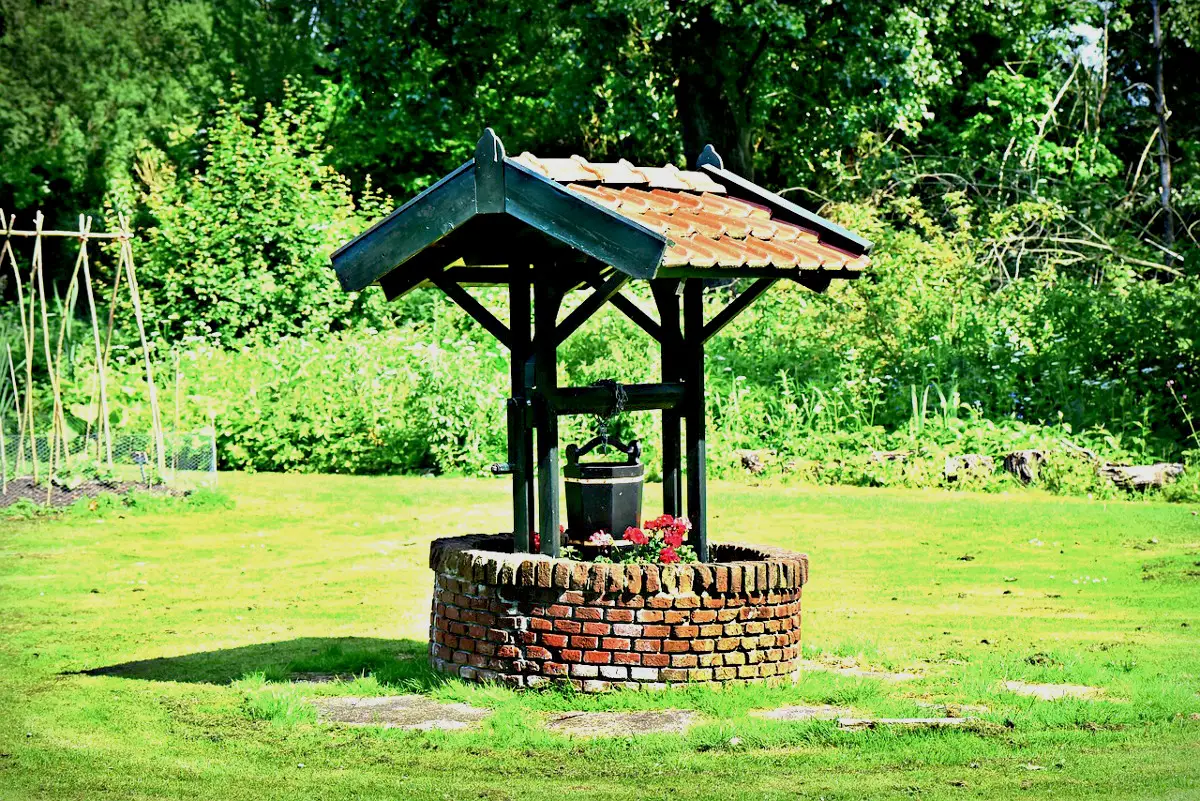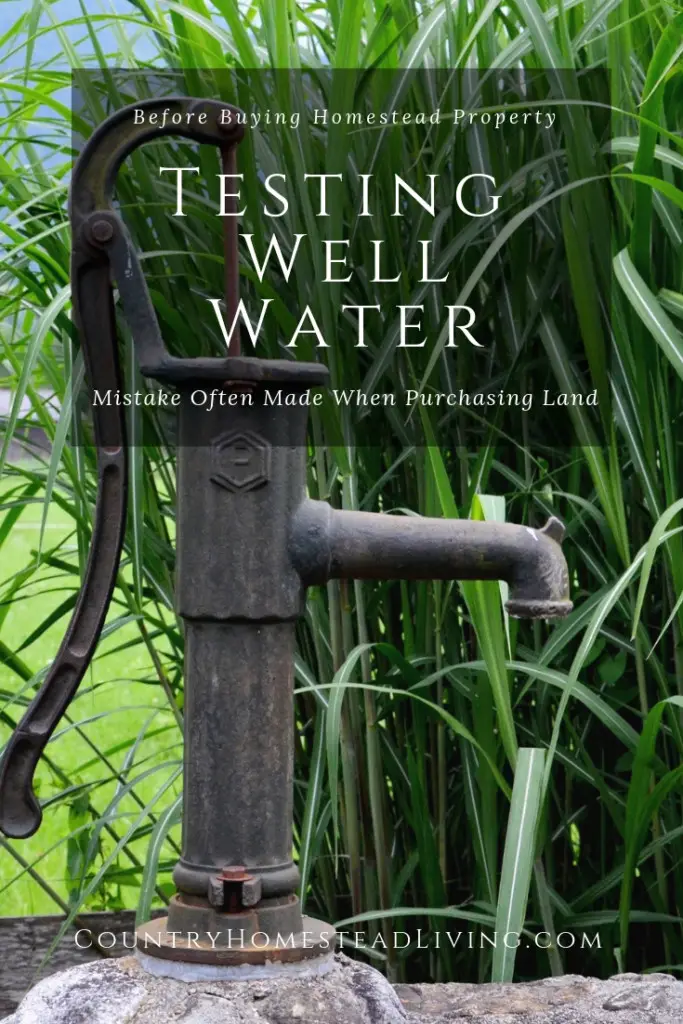One mistake often made when purchasing country property is a failure to get the water tested.
It is as if some people reason that the water was good enough for the previous residents so it is good enough for me.
But, should well water be tested before buying a Homestead?
Yes, the EPA recommends testing well water once a year for Total Coliform Bacteria, Nitrates, Total dissolved solids and pH levels.
When the health of your family is at stake, it makes good sense to test the well water before purchasing land.
Several years ago we rented a house in the country that had a well.
We lived in that house for 2 years and did not have the water tested.
Maybe we were just fortunate.
It does not appear that we have any health problems from renting that house.
But that was probably from the fact that we filtered the drinking and cooking water through a Big Berkey Water Filter by British Berkefeld.
However, we learned a few years later that the owners, who moved back in after we moved away, had both died in a short period of time of some type of cancer.
One person who was telling us this thought it may have been due to something in the well water!
In this article we will take a look at why testing well water before purchasing Homestead Property is imperative.
EPA Recommendations For Testing Well Water
The Federal Environmental Protection Agency recommends testing for Total Coliform Bacteria, nitrates, total dissolved solids and pH levels once a year.
The EPA also recommends testing for tannins, hardness, chloride and copper every 2-3 years.
Where Do I Get The Water Tested
All well water should be professionally tested by a State Certified Lab.
The local County Health Department can tell you where the lab is located and give contact information.
Talk with the lab to learn how to correctly collect a water sample for testing.
Many labs have a kit that contains instructions that they will send to you.
It can take up to 2 weeks to receive the results of the water test.
Once you get the results of the water test, ask to have the results clearly explained to you.
Have the Health Department or the testing lab refer you to someone who can show you the best options for removing any contaminants that might be found.
The recognized designation for experts on treating water is a Certification by the Water Quality Association.
Many contaminants can be removed by water softeners, filters or treatment systems.
Most water treatment systems are self-cleaning and have a minimum flow rate of water through them.
The well’s gallons per minute (GPM) flow rate needs to meet or exceed this minimum flow rate!
All water treatment systems reduce the water pressure.
If the well does not have good pressure before having a treatment system installed, the water pressure will be unacceptable after the treatment system has been installed.
You can ask the property owner if he or she has a Regular Water Testing Schedule.
If they do, ask to see there file that has the testing results.
Smart property owners know that a water testing file helps identify when a water problem arises and is helpful in determining the cause of the problem.
What Does A Water Test Cost
The cost depends on what contaminants are being tested for.
To know what to have the water tested for requires some research into water problems in the area.
Talking to the local Health Department, local well drillers and local pump companies can reveal contaminants that have been found in the water for that particular area.
These contaminants would be what you should have the water tested for.
A web search for water contaminants can begin with a query for “water contaminants in (area)”.
It can be helpful researching the EPA’s website or the USGS website, (U.S. Geological Service).
Inquire as to the need to test for Volatile Organic Compounds (VOCs) such as MtBE and benzene that are found in gasoline.
These compounds can be found anywhere in the U.S.
But commonly occur in California, Nevada, Florida, as well as the New England and Mid-Atlantic States.
There are different tests to choose from. Low cost tests usually include pH, alkalinity, hardness and turbidity.
Standard Mineral Tests can include iron, calcium, manganese, copper, fluoride, chlorine, and other minerals.
In rural areas you should always request testing for Coliform Bacteria. (Bacteria found in human and animal excrement.)
Costs of testing water can range from a low of $35 up to about $400.
It is also important to test well water for the presence of Radon Gas.
You can read what I wrote about it titled, “Radon Gas (Health Hazard, Test, Water, Air, Reduce In Home”.
Test Both Water Quality And Quantity
Water quality testing is testing for contaminants.
Water quantity testing is testing the well’s output to know if there is sufficient water for your homestead needs.
Groundwater, water held underground in the soil or in pores and cracks of rocks, is the source of water from wells.
In many instances groundwater is a shared resource across many square miles of land.
This means that contaminants can affect a large area.
And that drought spells can decrease the GPM output of wells on many properties.
To determine water needs you do not just multiply the well’s output in gallons per minute (GPM) flow times the minutes in a day.
That gives the total water output of a well per day, not adequate flow for your needs.
On a homestead there can be several demands for water at the same time.
There could be more than one source of water being used to water the garden, orchard or berry bushes going at the same time.
Someone else could be watering stock and there could be clothes to wash or showers to take all at the same time.
A 5 GPM well flow can give a sufficient total water output per day yet not be sufficient flow for your needs.
If there is a large garden, orchard and lots of berry bushes, the ideal time to water them is before the heat of the day.
Even with a drip system where applicable or soaker hoses for berry bushes, it could take 15 GPM when an orchard is added.
A typical water quantity test involves pumping a well for 1 hour.
And then measuring the well’s output over the next hour and breaking that down into GPM flow.
Remember that the well’s output will diminish in late summer, the time that it is critical to have sufficient water for a good harvest.
If you are looking at property to purchase, testing the water is the Seller’s responsibility.
It is the Seller who is holding his land out as land valuable to purchase.
If the Seller balks at paying for water testing, you should be very wary of this piece of property.
Even if the Seller offers test results from years previous but no recent tests, I’d hold out for recent tests or look elsewhere for land.
Have well water tested when there is any change in color, odor or flavor of the water.
A well with a submersible pump suspended on a stranded cable with oil on the strands that has not been used for a year can have a particular problem.
A slime bacteria can grow in the oil around the cable strands and give the water a green slimy look, oily feel and funny taste.
This problem is best treated by a pump company.
Quantity Of Water Facts
A standard 6″ diameter well casing stores 1.5 gallons of water per foot.
This is called the Water Storage Capacity.
To figure this capacity you need to know how far down into the well the casing extends and what the Static Water Level in the well is.
The Static Water Level is how far down in the casing it is to the water when the well is not pumping.
An example of Water Storage Capacity would be a casing extending down 100′ and a Static Water Level of 50′.
This would give a Water Storage Capacity of 75 gallons.
(100′ – 50′ = 50 ‘ X 1.5 gallons per foot = 75 gallons).
An average home uses 100-120 gallons of water per person per day.
There are times when the water demands per person come at the same time.
This can easily require 6 to 12 GPM of water which exceeds a 5 GPM well’s output.
A homestead can require periods when even more water is needed.
To understand the daily needs for water on a homestead you can read an article I wrote titled, “Daily Homestead Water Needs (Determining Amounts Necessary.”
If the well’s output in GPM is insufficient there are 2 solutions to this problem.
1) drill another well which can cost $15,000 or more
Or
2) see if Hydrofracking will improve the well’s GPM output.
Hydrofracking is the injection of water at high pressure into the well.
This can widen the fractures in the bedrock and extend them further.
This allows more water to flow into the well.
Hydrofracking works best if the well gets it’s water from water moving through fissures and fractures in the bedrock.
Do not confuse Hydrofracking of a water well with Fracking of an oil or natural gas well.
Water wells are much shallower than oil or natural gas wells.
And Hydrofracking does not lead to contamination of the water supply with oil or natural gas.
Interesting Water Well Facts
The average well depth in the Eastern U.S. is not much over 50 feet.
If a well is less than 40 feet deep it is technically not a well but surface water.
It takes 40 feet of soil, sand, rock etc. to filter the contaminants out of surface water and purify the water.
The average lifespan of a well is 30-50 years.
The lifespan can be longer or shorter depending on several factors.
As a well’s age increases, it’s GPM flow can decrease due to the lowering of the water table.
This is why a fairly recent Quantity Test is important when wanting to establish a Homestead on property with an existing well!
There should be 100′ distance minimum between a well and any part of a septic system, barnyard or chicken yard to prevent contamination.
If the septic system, barnyard or chicken yard is on a higher elevation than the well, the distance needs to be increased between them.
Ideally the well should be on level ground with the ground bermed to prevent puddling around the well.
If the well is uphill from any source of contamination, runoff from rains or snow melt will not accumulate around the well.
The well should be at least 50′ from the nearest corner of the house.
And at least 10′ from any shed or outbuilding to give room to work on the well when needed.
A good well pump should last 10 years or more.
A new pressure tank is needed about every 15 years.
If the well is 20 years old it is time to get it inspected by a pump company to see what could be expected to fail at anytime.
It’s always a nice idea to get a second pump company’s opinion also.
The best type of a well is a Drilled Well.
They are at least 40′ deep with a pipe or well head sticking out of the ground for at least a foot and closed on the top end.
A dug well is usually less than 40′ deep, are less reliable and are more prone to contamination.
What Potential Contaminants Are Upstream
It is very helpful to know what potential sources of contamination are upstream from a well.
There are parts of the country that have a lot of caves with bats and the water could flow through one of those caves and contaminate the well water or an entire aquifer.
If there were mining operations upstream there could be leftover toxic chemicals that leached into the groundwater and contaminated a well or aquifer.
A previous or current gas station or automobile junkyard upstream can also be a source of contamination of a well or underground aquifer.
Having well water tested before purchasing property is something no serious homesteader should omit.
Related Questions
Do you have to pay for water if you have a well?
If you have a hand pump the price you pay for water is the effort to pump it with the hand pump.
If you have an electric pump you either pay for the electricity to pump the water out or if it is an alternative energy system a portion of the cost of that system was paid to pump water.
Some Western States, like Washington, have begun putting meters on rural wells.
Those who have had the meters placed on their wells have been told that eventually they will pay for the water from under their property.
Some homesteaders consider this to be reason enough to avoid Washington State as a homestead site.
How can you tell if water is clean?
The only way to tell for sure is to have the water tested. Bacteria that can cause illness can be present in well water that looks perfectly clean and clear.
Have the water tested for compounds that are common in the area plus for Coliform bacteria. (Bacteria from human and animal feces).
Should I buy a house with Coliform Bacteria in the well?
The answer is NO!!!!!
The Seller should have the well treated and prove the absence of Coliform Bacteria by a new well water test from a Certified Lab.
Only then would I consider buying that land.
But first I’d be sure that the proper distances from the septic system, barnyard and chicken coop were followed as in the above article.
Websites For Helpful Information
Drinking Water Contaminants: https://www.epa.gov/dwstadardregulations
Private Drinking Water Wells: https://www.epa.gov/privatewells
Unsafe Water Sample: www.cleanwatertesting.com/wp-content/uploads/2016/01/CWY-101-Reasons-Handout_web.pdf
Well Cleaning/Disinfection Instructions: www.cleanwatertesting.com/wp-content/uploads/2015/04/WELL-CLEANING-INSTRUCTIONS.pdf


